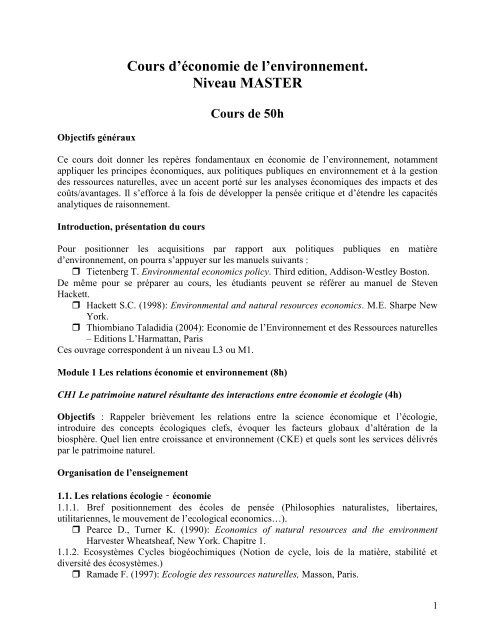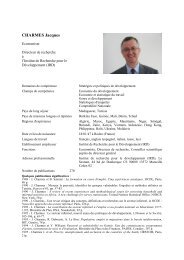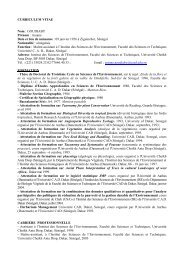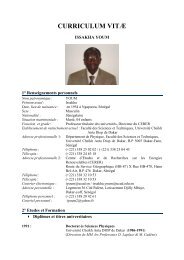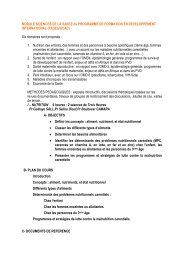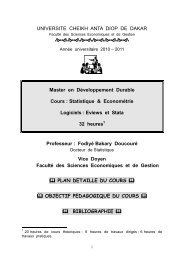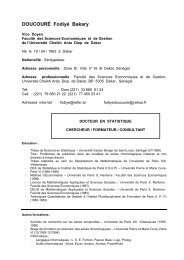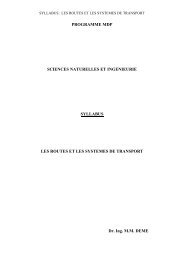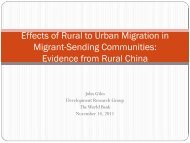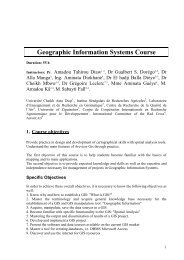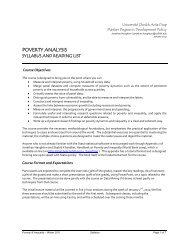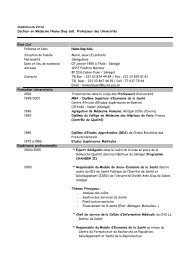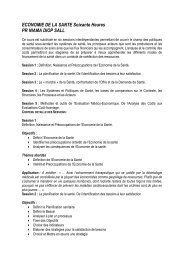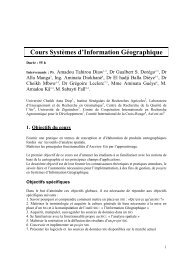Syllabus du cours d'économie de l'environnement - MDP UCAD
Syllabus du cours d'économie de l'environnement - MDP UCAD
Syllabus du cours d'économie de l'environnement - MDP UCAD
Create successful ePaper yourself
Turn your PDF publications into a flip-book with our unique Google optimized e-Paper software.
1.2. Facteurs <strong>de</strong> pression sur la biosphère1.2.1. Démographie. Situation et théorie <strong>de</strong> la transition démographique1.2.2. Energie. Situation et tendances1.2.3. Croissance <strong>de</strong>s richesses. Situation et tendances Statistiques ONU. World Bank (1992 et suivantes): The world Development Report.1.3. L’hypothèse <strong>de</strong> la courbe <strong>de</strong> Kuznetz environnementale (CKE) Common M. S. (1995) Sustainability and Policy: Limits to Economics, CambridgeUniversity Press1.4. Les services livrés par le patrimoine naturel et leur évolution1.4.1. Contribution <strong>de</strong>s services environnementaux au bien‐être1.4.2. Les facteurs <strong>de</strong> changement1.4.3. Les principales conclusions <strong>de</strong> l’évaluation <strong>de</strong>s écosystèmes pour le millénaire. Dasgupta, P. (2001): Human Well-Being and the Natural Environment. Oxford UniversityPress, Oxford. Millennium Ecosystem Assessment (2005): Ecosystems and Human Well-being:Opportunities and Challenges for Business and In<strong>du</strong>stry. Island Press, Washington, DC. Millennium Ecosystem Assessment (2005): Ecosystems and human well-being. Synthesis.Island Press, Washington, DC. 155p.Ouvrages <strong>de</strong> référenceMillennium Ecosystem Assessment (2005): Ecosystems and Human Well-being: Opportunitiesand Challenges for Business and In<strong>du</strong>stry. Island Press, Washington, DC.Millennium Ecosystem Assessment (2005): Ecosystems and human well-being. Synthesis.Island Press, Washington, DC. 155p.World Bank (1992 et suivantes): The world Development Report.Rama<strong>de</strong> F. (1997) : Ecologie <strong>de</strong>s ressources naturelles, Masson, Paris.Common M. S. (1995): Sustainability and Policy: Limits to Economics Cambridge UniversityPress.Dasgupta, P. (2001): Human Well-Being and the Natural Environment. Oxford University Press,Oxford.Thiombiano Taladidia (2004): Economie <strong>de</strong> l’Environnement et <strong>de</strong>s Ressources naturelles –Editions L’Harmattan, ParisCH 2 Actifs environnementaux et défaillances <strong>de</strong> marché (4h)Objectifs : Explorer les situations d’échec <strong>du</strong> marché dans l’allocation <strong>de</strong>s biens et servicesenvironnementaux. Les étudiants doivent comprendre pourquoi les spécificités <strong>de</strong>s actifs naturels2
peuvent con<strong>du</strong>ire à une allocation marchan<strong>de</strong> non efficiente et pourquoi il est nécessaired’intervenir pour corriger ces défaillances.Organisation <strong>de</strong> l’enseignement2.1. Droits <strong>de</strong> propriété, marchés incomplets, théorème <strong>de</strong> Coase Hoffman E., Spitzer M. (1982): The Coase theorem ; some experimental tests. Journal ofLaw and Economics 25, 73‐98. Baumol W.J., Oates W.E. (1988): The Theory of Environmental Policy CambridgeUniversity Press, Cambridge.2.2. Externalités Varian H.R. (1987): Intermediate microeconomics, 2nd edition Norton, New York.2.3. Non exclusion et gestion <strong>de</strong>s communs Ostrom E. (1990): Governing the commons: the evolutions of institutions for collectiveactions. Cambridge University Press, Cambridge.2.4. Non‐rivalité et biens publics environnementaux Cornes R., Sandler T. (1996): The Theory of Externalities, Public Goods and Club Goods.2nd edition, Cambridge University Press, Cambridge.Ouvrages <strong>de</strong> référence:Baumol W.J., Oates W.E. (1988): The Theory of Environmental Policy Cambridge UniversityPress, Cambridge.Cornes R., Sandler T. (1996): The Theory of Externalities, Public Goods and Club Goods. 2 ndédition, Cambridge University Press, Cambridge.Thiombiano Taladidia (2004): Economie <strong>de</strong> l’Environnement et <strong>de</strong>s Ressources naturelles –Editions L’HarmattanApplication : droit <strong>de</strong> propriété et biodiversité.Parmi les différents services associés à la biodiversité que l’homme peut mobiliser à son profit,on s’attachera ici à la contribution à l’in<strong>du</strong>strie pharmaceutique. Point P. (2003): L’altération <strong>de</strong>s récifs coralliens. Evaluation économique <strong>de</strong> la perte <strong>de</strong>biodiversité en tant que potentiel pharmaceutique in S. FERRARI, P. POINTPréservation et valorisation <strong>de</strong> l’eau dans le domaine littoral. Karthala, Paris, 215‐230. Simpson R.D., Sedjo R.A., Reid J.W. (1996): Valuing Biodiversity for use inpharmaceutical research. Journal of Political Economy 104(4), 163‐184.Mo<strong>du</strong>le 2 Ressources naturelles, rente et indicateurs <strong>de</strong> rareté (12h)Révisions sur l’application <strong>de</strong>s métho<strong>de</strong>s <strong>de</strong> Lagrange aux problèmes d’allocation dynamique <strong>de</strong>sressources en temps discret et continu. Hamiltonien, diagramme <strong>de</strong> phase.3
Conrad J.M., Clark C.W. (1987): Natural resource Economics. Notes andProblems.(1987) Cambridge University Press, Cambridge, Chapitre 1. Thiombiano Taladidia (2004): Economie <strong>de</strong> l’Environnement et <strong>de</strong>s Ressources naturelles– Editions L’Harmattan, ParisCh3 Ressources non renouvelables (6h)Objectifs : Comprendre le problème d’allocation intertemporelle, apprécier les différentesmesures <strong>du</strong> stock, comprendre les phénomènes <strong>de</strong> substitution et l’effet d’une « backstoptechnology », construire et résoudre un problème simple en version discrète et continue d’unmodèle d’épuisement <strong>de</strong> la ressource, comparer les résultats d’une approche en termes <strong>de</strong>concurrence et <strong>de</strong> planification et saisir les effets d’une structure <strong>de</strong> marché monopolistique.Organisation <strong>de</strong> l’enseignement3.1. Exploitation optimale, coûts d’exploitation exogènes et endogènes avec effet <strong>de</strong> stock. Conrad J.M., Clark C.W. (1987): Natural resource Economics. Notes andProblems.(1987) Cambridge University Press, Cambridge, Chapitre 3. Hartwick J.M., Olewiler N.D. (1988): The economics of natural resource use. Harper andRow, New York. Rotillon G. (2005): Economie <strong>de</strong>s ressources naturelles. Collection Repères. LaDécouverte, Paris. Thiombiano Taladidia (2004): Economie <strong>de</strong> l’Environnement et <strong>de</strong>s Ressources naturelles– Editions L’Harmattan3.2. In<strong>du</strong>stries compétitives et monopolistiques Dasgupta P.S., Heal G.M. (1979): Economic theory and exhaustible resources CambrigeEconomic Handbook, Cambridge University Press. Ch 113.3. Indicateurs <strong>de</strong> raréfaction. Brown G.M., Field B.C. (1978): Implications of alternative measures of natural resourcescarcity Journal of Political Economy 86, 229‐244.Ouvrages <strong>de</strong> référence :Conrad J.M., Clark C.W. (1987): Natural resource Economics. Notes and Problems.(1987)Cambridge University Press, Cambridge, Chapitre 3.Neher P.A. (1990): Natural Resource Economics. Conservation and Exploitation. CambridgeUniversity Press, Cambridge, Chapitres 15‐20.Rotillon G. (2005): Economie <strong>de</strong>s ressources naturelles. Collection Repères. La Découverte,Paris.Thiombiano Taladidia (2004): Economie <strong>de</strong> l’Environnement et <strong>de</strong>s Ressources naturelles –Editions L’Harmattan, Paris4
Ch4 Ressources renouvelables (6h)Objectifs : L’étudiant doit pouvoir, comprendre la fonction <strong>de</strong> croissance biologique d’uneressource renouvelable, interpréter le modèle logistique simple et ses variantes, comprendre leconcept <strong>de</strong> prélèvement maximum d’équilibre, distinguer les états <strong>de</strong> régime permanent et lesajustements dynamiques qui peuvent y con<strong>du</strong>ire, apprécier les conséquences d’une situationd’accès libre.Organisation <strong>de</strong> l’enseignement4.1. Fonctions <strong>de</strong> croissance, prélèvement maximum d’équilibre, Conrad J.M. (1995): Bioeconomic Mo<strong>de</strong>ls of the Fishery in D.W. Bromley (ed) TheHandbook of environmental economics Blackwell, Mal<strong>de</strong>n. Chapitre 18.4.2. Récolte optimale, stratégie optimale d’investissement Conrad J.M., Clark C.W. (1987): Natural resource Economics. Notes andProblems.(1987) Cambridge University Press, Cambridge, Chapitre 2.4.3. Gestion privée, gestion en accès libre. Conrad J.M., Clark C.W. (1987): Natural resource Economics. Notes andProblems.(1987) Cambridge University Press, Cambridge, Chapitre 2. Neher P.A. (1990): Natural Resource Economics. Conservation and Exploitation.Cambridge University Press, Cambridge, Chapitres 10‐12. Rotillon G. (2005): Economie <strong>de</strong>s ressources naturelles. Collection Repères. LaDécouverte, Paris.Application : la forêt équatoriale entre gestion minière et renouvelable.Réflexions sur l’afforestation et le taux <strong>de</strong> rotation forestière. Montgomery C.A., Adams D.M. Optimal timber management policies in D.W. Bromley(ed) The Handbook of environmental economics Blackwell, Mal<strong>de</strong>n. Chapitre 17. Karsenty A. (1999): Les instruments économiques <strong>de</strong> la forêt tropicale. Editions CIRAD.Ouvrages <strong>de</strong> référence :Conrad J.M., Clark C.W. (1987): Natural resource Economics. Notes and Problems. (1987)Cambridge University Press, Cambridge, Chapitre 2.Rotillon G. (2005): Economie <strong>de</strong>s ressources naturelles. Collection Repères. La Découverte,Paris.Neher P.A. (1990): Natural Resource Economics. Conservation and Exploitation. CambridgeUniversity Press, Cambridge, Chapitres 10‐12.Mo<strong>du</strong>le 3 Evaluation environnementale et projets à impacts environnementaux (12h)Ch 5 Evaluation environnementale (8h)Objectifs : L’étudiant doit maîtriser la théorie <strong>de</strong> l’utilité sur laquelle les évaluations sont basées.Il lui faut saisir les possibilités et limites d’un exercice <strong>de</strong> simulation <strong>du</strong> marché. Il doitcomprendre comment la métho<strong>de</strong> <strong>de</strong>s coûts <strong>de</strong> déplacements permet <strong>de</strong> dé<strong>du</strong>ire une valeur5
d’usage à partir <strong>de</strong> l’observation <strong>de</strong>s comportements. Il doit comprendre également lesprocé<strong>du</strong>res <strong>de</strong> génération <strong>de</strong> données à partir <strong>de</strong> l’évaluation contingente et les mo<strong>de</strong>s <strong>de</strong>traitement associés ainsi que les possibilités et limites qui en résultent. Les métho<strong>de</strong>s d’évaluation<strong>du</strong> surplus <strong>du</strong> pro<strong>du</strong>cteur doivent également être connues.Organisation <strong>de</strong> l’enseignement5.1. Le cadre théorique5.1.1. Légitimité <strong>de</strong> l’approche, divers types <strong>de</strong> valeurs. Vatn A., Bromley D.W. (1995): Choices without prices without apologies in D.W.Bromley (ed) The Handbook of environmental economics Blackwell, Mal<strong>de</strong>n. Chapitre 1.5.1.2. Mesures compensées <strong>du</strong> surplus Johansson P.O. (1987): The Economic Theory and Measurement of EnvironmentalBenefits. Cambridge University Press, Cambridge. Varian H.R. (1987): Intermediate microeconomics, 2nd edition Norton, New York. Bishop R.C., Woodward R.T. (1995): Valuation of environmental quality un<strong>de</strong>r certaintyin D.W. Bromley (ed) The Handbook of environmental economics Blackwell, Mal<strong>de</strong>n.Chapitre 24.5.1.3. Variations <strong>de</strong> quantité avec offre contingentée Johansson P.O. (1987): The Economic Theory and Measurement of EnvironmentalBenefits. Cambridge University Press, Cambridge. Varian H.R. (1987): Intermediate microeconomics, 2nd edition Norton, New York. Bishop R.C., Woodward R.T. (1995): Valuation of environmental quality un<strong>de</strong>r certaintyin D.W. Bromley (ed) The Handbook of environmental economics Blackwell, Mal<strong>de</strong>n.Chapitre 24.5.1.4. Relations <strong>de</strong> complémentarité et substituabilité, complémentarité faible. Johansson P.O. (1987): The Economic Theory and Measurement of EnvironmentalBenefits. Cambridge University Press, Cambridge5.2. Les métho<strong>de</strong>s5.2.1. La métho<strong>de</strong> <strong>de</strong>s coûts <strong>de</strong> déplacements Desaigues B., Point P. (1993): Economie <strong>du</strong> Patrimoine Naturel. La valorisation <strong>de</strong>sbénéfices d’environnement. Economica, Paris. Chapitre 2. Bonnieux F., Desaigues B. (1998): Economie et politiques <strong>de</strong> l’environnement Dalloz,Paris. Chapitre 25.2.2. La métho<strong>de</strong> d’évaluation contingente Desaigues B., Point P. (1993): Economie <strong>du</strong> Patrimoine Naturel. La valorisation <strong>de</strong>sbénéfices d’environnement. Economica, Paris. Chapitre 5. Bonnieux F., Desaigues B. (1998): Economie et politiques <strong>de</strong> l’environnement Dalloz,Paris. Chapitre 35.2.3. La métho<strong>de</strong> <strong>de</strong>s prix hédonistes Desaigues B., Point P. (1993): Economie <strong>du</strong> Patrimoine Naturel. La valorisation <strong>de</strong>sbénéfices d’environnement. Economica, Paris. Chapitre 4. Bonnieux F., Desaigues B. (1998): Economie et politiques <strong>de</strong> l’environnement Dalloz,Paris. Chapitre 4.5.2.4. Les métho<strong>de</strong>s reliées à la fonction <strong>de</strong> pro<strong>du</strong>ction Desaigues B., Point P. (1993): Economie <strong>du</strong> Patrimoine Naturel. La valorisation <strong>de</strong>sbénéfices d’environnement. Economica, Paris. Chapitre 86
Ellis G.M., Fisher A.C. (1987): Valuing the environment as an input. Journal ofEnvironmental Management 25, 149‐156. Point P. (1994): The Value of Non‐Market Assets as Pro<strong>du</strong>ction Factor in R. Pethig (ed)Valuing the Environment: Methodological and Measurement Issues. Kluwer, Dordrecht,Pays‐Bas, 23‐57.Ouvrages <strong>de</strong> référence :Bonnieux F., Desaigues B. (1998): Economie et politiques <strong>de</strong> l’environnement Dalloz, Paris.Desaigues B., Point P. (1993): Economie <strong>du</strong> Patrimoine Naturel. La valorisation <strong>de</strong>s bénéficesd’environnement. Economica, Paris. Chapitre 1.Johansson P.O. (1987): The Economic Theory and Measurement of Environmental Benefits.Cambridge University Press, Cambridge.Johansson P.O. (1993): Cost-Benefit analysis of Environmental Change Cambridge UniversityPress, Cambridge.Thiombiano Taladidia (2004): Economie <strong>de</strong> l’Environnement et <strong>de</strong>s Ressources naturelles,Editions l’Harmattan, ParisCh 6 L’intégration <strong>de</strong>s coûts et bénéfices environnementaux dans l’ACA (4h)Objectifs : Le <strong>cours</strong> vise ici, à montrer comment élargir l’Analyse Coût-Avantage (ACA) pourintégrer les impacts environnementaux et à amener l’étudiant à réfléchir sur la portée <strong>de</strong>l’actualisation sur le temps long.Organisation <strong>de</strong> l’enseignement6.1. Etu<strong>de</strong>s d’impact. Analyse coût‐avantage élargie à l’environnement. Johansson P.O. (1993): Cost-Benefit analysis of Environmental Change CambridgeUniversity Press, Cambridge. OCDE (2007) Analyse coûts-avantages et environnement, Développements récents. Paris.6.2. Le modèle <strong>de</strong> Krutilla-Fisher Porter R.C. (1982): The new approach to wil<strong>de</strong>rness preservation through cost benefitanalysis. Journal of Environmental Economics and Management 9, 59-80.Ouvrages <strong>de</strong> référence :Desaigues B., Point P. (1993): Economie <strong>du</strong> Patrimoine Naturel. La valorisation <strong>de</strong>s bénéficesd’environnement. Economica, Paris. Chapitre 9, 10.Johansson P.O. (1993): Cost-Benefit analysis of Environmental Change Cambridge UniversityPress, Cambridge.7
OCDE (2007): Analyse coûts-avantages et environnement, Développements récents. Paris.Mo<strong>du</strong>le 4 Instruments <strong>de</strong> régulation et développement <strong>du</strong>rable (18h)Ch 7 Les instruments <strong>de</strong> régulation <strong>de</strong> la pollution (10h)Objectifs : Après avoir suivi les enseignements <strong>de</strong> ce chapitre, l’étudiant doit comprendre :Comment les solutions <strong>de</strong> marchandage peuvent con<strong>du</strong>ire à un niveau efficient <strong>de</strong> pollution,quelles sont les limites à ce processus pour résoudre les problèmes <strong>de</strong> pollution, quelle est lalogique d’une taxe pigovienne, quelles sont les propriétés d’un système <strong>de</strong> normes, <strong>de</strong> taxesd’émission <strong>de</strong> marché <strong>de</strong> permis <strong>de</strong> pollution, comment atteindre un objectif <strong>de</strong> pollutionacceptable avec différents instruments. L’étudiant doit aussi comprendre le rôle <strong>de</strong>s mécanismes<strong>de</strong> responsabilité et les effets d’une fiscalité environnementale.Remarque : les analyses se transposent en partie à d’autres contextes <strong>de</strong> régulation : régulation <strong>de</strong>l’accès à un aquifère, régulation d’une pêcherie, …Organisation <strong>de</strong> l’enseignement7.1. Les instruments lorsque la résolution par marchandage n’est pas possible. Bohm P., Russell C. (1985): Comparative Analysis of Alternative Policy Instruments, inKneese A.V., Sweeney J.L. Handbook of Natural Resource and Energy EconomicsNorth-Holland, Amsterdam.7.2. Taxe pigovienne (Equilibre partiel et équilibre général) Baumol W.J., Oates W.E. (1988): The Theory of Environmental Policy CambridgeUniversity Press, Cambridge.7.3. La norme (Normes d’émission, normes technologiques) Baumol W.J., Oates W.E. (1988): The Theory of Environmental Policy CambridgeUniversity Press, Cambridge.7.4. Taxe sur les émissions et subventions à la dépollution Bürgenmeir B., Harayama Y., Wallart N. (1997): Théorie et pratique <strong>de</strong>s taxesenvironnementales. Economica Paris344p. OCDE (2006): Économie politique et taxes liées à l’environnement. Paris 215p.7.4. Marché <strong>de</strong> permis <strong>de</strong> pollution Stavins R.N. (1995): « Transaction Costs and Tra<strong>de</strong>able Permits », Journal ofEnvironmental Economics and Management, 29, 133-148. Tietenberg T.H. (1990): Economic Instruments for Environmental Regulation OxfordReview of Economic Policy 6, 17-33.7.5. Mécanismes <strong>de</strong> responsabilité OCDE (2005): Analytical framework for evaluating the costs and benefits of exten<strong>de</strong>dpro<strong>du</strong>cer responsibility programs.7.6. Fiscalité environnementale et problématique <strong>du</strong> double divi<strong>de</strong>n<strong>de</strong>. Goul<strong>de</strong>r L.H. (1995): "Environmental Taxation and the Double Divi<strong>de</strong>nd: A Rea<strong>de</strong>r'sGui<strong>de</strong>", International Tax and Public Finance, 2, 157-183.8
Ouvrages <strong>de</strong> référence :Bohm P., Russell C. (1985): Comparative Analysis of Alternative Policy Instruments, in KneeseA.V., Sweeney J.L. Handbook of Natural Resource and Energy Economics North-Holland,Amsterdam.Bontems P., Rotillon G. (2003): Economie <strong>de</strong> l’environnement Collection Repères, LaDécouverte, Paris.OCDE (1994): Gérer l’environnement. Le rôle <strong>de</strong>s Instruments économiques. Paris.OCDE (2008): Politiques <strong>de</strong> <strong>l'environnement</strong> : quelles combinaisons d'instruments ? ParisThiombiano Taladidia (2004): Economie <strong>de</strong> l’Environnement et <strong>de</strong>s Ressources naturelles,Editions l’Harmattan, ParisCh 8 Environnement et développement (8h)Objectifs: L’étudiant doit comprendre le concept <strong>de</strong> soutenabilité et l’importance <strong>de</strong>s possibilités<strong>de</strong> substitution dans le maintien d’un niveau <strong>de</strong> consommation. Il doit comprendre les différencesentre soutenabilité faible et forte et prendre la mesure <strong>de</strong> la règle <strong>de</strong> Hartwick et <strong>de</strong>s différentscritères d’équité intergénérationnelle. La création d’un cadre <strong>de</strong> comptabilité <strong>du</strong> patrimoinenaturel permet d’éclairer ces questions.Organisation <strong>de</strong> l’enseignement8.1. Concepts <strong>de</strong> soutenabilité Dietz S., Neumayer E. (2007): Weak and strong sustainability in the SEEA: Concepts andmeasurement Ecological Economics, 61, 617-626.8.2. Soutenabilité faible et règle <strong>de</strong> Hartwick Hartwick J.M. (1977): Intergenerational equity and the investing of rents from exhaustibleresources American Economic Review 67, 972-974.8.3. Soutenabilité faible et équité intergénérationnelle : maximin, règle <strong>de</strong> Chichilnisky Rotillon G. (2005): Economie <strong>de</strong>s ressources naturelles. Collection Repères. LaDécouverte, Paris.8.4. Revenu national Hicksien Rotillon G. (2005): Economie <strong>de</strong>s ressources naturelles. Collection Repères. LaDécouverte, Paris.8.5. Soutenabilité forte et capital naturel critique Randall A., Farmer M.C. (1995): Benefits, costs and the safe minimum standard ofconservation in D.W. Bromley (ed) The Handbook of environmental economicsBlackwell, Mal<strong>de</strong>n. Chapitre 2.8.6. Comptabilisation <strong>du</strong> patrimoine naturel.9
Dietz S., Neumayer E. (2007): Weak and strong sustainability in the SEEA: Concepts andmeasurement Ecological Economics, 61, 617-626. Pearce D. Atkinson G. (1995): Measuring sustainable <strong>de</strong>velopment in D.W. Bromley (ed)The Handbook of environmental economics Blackwell, Mal<strong>de</strong>n. Chapitre 8. United Nations, European Commission, International Monetary Fund, Organisation forEconomic Cooperation and Development, World Bank (2003) Handbook of NationalAccounting. Integrated Environmental and Economic Accounting. Washington, 591p.Ouvrages <strong>de</strong> référence :Dietz S., Neumayer E. (2007): Weak and strong sustainability in the SEEA: Concepts andmeasurement Ecological Economics, 61, 617-626.Rotillon G. (2005): Economie <strong>de</strong>s ressources naturelles. Collection Repères. La Découverte,Paris.United Nations, European Commission, International Monetary Fund, Organisation for EconomicCooperation and Development, World Bank (2003) Handbook of National Accounting.Integrated Environmental and Economic Accounting. Washington, 591p.Thiombiano Taladidia (2004): Economie <strong>de</strong> l’Environnement et <strong>de</strong>s Ressources naturelles,Editions l’Harmattan, Paris10


